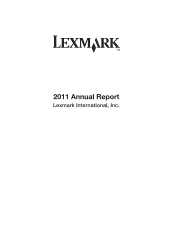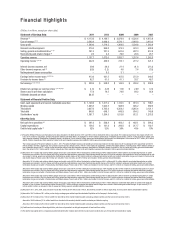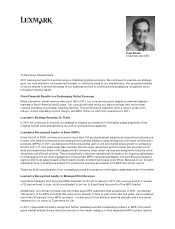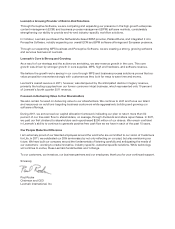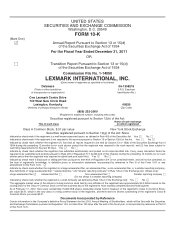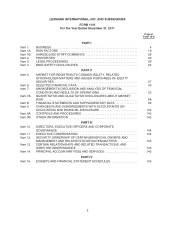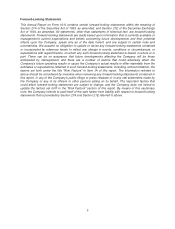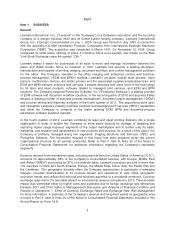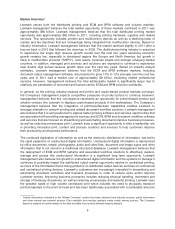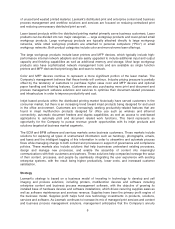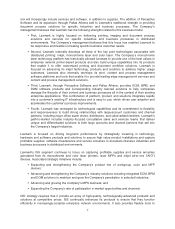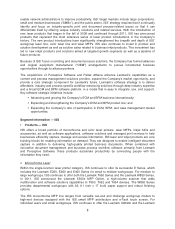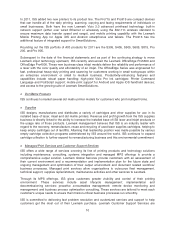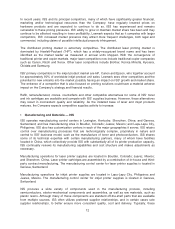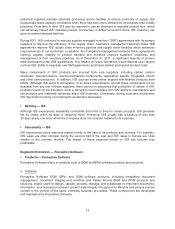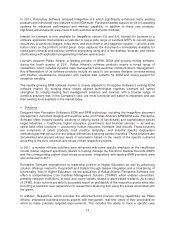Lexmark 2011 Annual Report Download - page 8
Download and view the complete annual report
Please find page 8 of the 2011 Lexmark annual report below. You can navigate through the pages in the report by either clicking on the pages listed below, or by using the keyword search tool below to find specific information within the annual report.Part I
Item 1. BUSINESS
General
Lexmark International, Inc., (“Lexmark” or the “Company”) is a Delaware corporation and the surviving
company of a merger between itself and its former parent holding company, Lexmark International
Group, Inc., (“Group”) consummated on July 1, 2000. Group was formed in July 1990 in connection
with the acquisition of IBM Information Products Corporation from International Business Machines
Corporation (“IBM”). The acquisition was completed in March 1991. On November 15, 1995, Group
completed its initial public offering of Class A Common Stock and Lexmark now trades on the New
York Stock Exchange under the symbol “LXK.”
Lexmark makes it easier for businesses of all sizes to move and manage information between the
paper and digital worlds. Since its inception in 1991, Lexmark has become a leading developer,
manufacturer and supplier of printing, imaging, document workflow, and content management solutions
for the office. The Company operates in the office imaging and enterprise content and business
process management (“ECM and BPM”) markets. Lexmark’s products include laser printers, inkjet
printers, multifunction devices, dot matrix printers and the associated supplies/solutions/services, and
ECM and BPM software solutions and services. Lexmark develops and owns most of the technology
for its laser and inkjet products, software related to managed print services, and ECM and BPM
solutions. The Company acquired Perceptive Software, Inc. (“Perceptive Software”), a leading provider
of ECM software and document workflow solutions, in the second quarter of 2010 and acquired Pallas
Athena, a leading provider of business process management, document output management (“DOM”)
and process mining and discovery software in the fourth quarter of 2011. The acquisitions build upon
and strengthen Lexmark’s industry workflow solutions and managed print services (“MPS”) capabilities
and allow the Company to compete in the faster growing ECM, BPM and document-process
automation software solutions markets.
In the fourth quarter of 2010, Lexmark combined its laser and inkjet printing divisions into a single
organization in order to enable the Company to more easily execute its strategy of targeting and
capturing higher usage business segments of the output marketplace and to further unify its sales,
marketing, and research and development of new products and services. As a result of this action, the
Company is primarily managed along two segments: Imaging Solutions and Services (“ISS”) and
Perceptive Software. The information included in this report has been prepared under the current
organizational structure for all periods presented. Refer to Part II, Item 8, Note 20 of the Notes to
Consolidated Financial Statements for additional information regarding the Company’s reportable
segments.
Revenue derived from international sales, including exports from the United States of America (“U.S.”),
accounts for approximately 58% of the Company’s consolidated revenue, with Europe, Middle East
and Africa (“EMEA”) accounting for 37% of worldwide sales. Lexmark’s products are sold in more than
170 countries in North and South America, Europe, the Middle East, Africa, Asia, the Pacific Rim and
the Caribbean. This geographic diversity offers the Company opportunities to participate in emerging
markets, provides diversification to its revenue stream and operations to help offset geographic
economic trends, and utilizes the technical and business expertise of a worldwide workforce. Currency
exchange rates had a 2% favorable impact on international revenue compared to 2010. This favorable
impact was somewhat offset by higher costs and expenses due to foreign exchange rate differences
between 2011 and 2010. Refer to Management’s Discussion and Analysis of Financial Condition and
Results of Operations — Effect of Currency Exchange Rates and Exchange Rate Risk Management
for more information. A summary of the Company’s revenue and long-lived assets by geographic area
is found in Part II, Item 8, Note 20 of the Notes to Consolidated Financial Statements included in this
Annual Report on Form 10-K.
4

